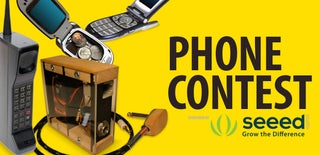Introduction: Cell Phone As Auxiliary Camera Lens
My cell phone has pretty much replaced my 18mm to 55mm lens these days, and I do most of my photography with the 250 mm zoom lens on a digital single-lens reflex camera (DSLR) - a Canon T2i - and my cell phone - a Motorola Moto G, with a perfectly fine camera. Where I used to have to swap out lenses, sometimes multiple times, to get the shot I wanted, I can usually now just keep the long lens on my camera and the cell phone in my pocket and capture almost ever shot I like quickly and easily.
For me, making the cell phone part of my camera ensemble:
- Lightens the carrying load
- Improves photographic efficiency
- Broadens the range of shots I can get
- Quickens access to and use of my photos
Step 1: Cell Phone Camera for First Person Views
The cell phone camera is great for quick, close up work - perfect for illustrating Instructables, because it can be used to take very accurate first person views of each step of a project. Its small size makes it ideal for one hand shooting, so you can stir or pour and still easily tap off a shot.
Step 2: Cell Phone Camera for Ease of Access
The cell phone makes a great stand alone camera for tabletop photography, as in our DIY Tabletop Studio project. There's no reason to deal with the bigger camera when the cell phone not only takes high quality photos, but as an Android device automatically pops the photos up into Google Photos for quick and easy access and use.
Step 3: Paired With DSLR for Range and Depth
Armed with the DSLR equipped with the telephoto lens, and my cell phone camera, I can stand in one spot and get two distinct views of a scene. In this pair of photos, after some recent street flooding, I was able to capture a wide view and then get a closer shot of a unique aspect of that view, within seconds of each shot.
Step 4: Scouting Shots
Using the cell phone camera can help set up shots for the longer lens, narrowing down views and lighting, revealing background issues you might want to take into consideration (like the car in the back of the wide shot) for closer shots or other angles with the DSLR.
Step 5: Making the Most of a Scene
Having both the cell phone camera and the longer lens allows you to make the most of a single shooting session. I stood in one spot to get all three shots within just a few seconds of each other, and I wasn't fumbling around to swap lenses.
Step 6: Achieving Different Effects
The two shots here were made in the same spot within moments of each other. Without having to swap out lenses, I was able to get two different effects in the same scene, the wide rushing water effect with wide cell phone shot, and the slower, deeper running water shot with the long lens.
Step 7: Making Field Notes for the DSLR
I almost always have my cell phone with me, and when I see something that would be better photographed with the DSLR and want to remember where I saw it, snapping a cell phone shot (even a blurry one) will give me the landmarks or street signs to get back to that spot for a better shot with the right lens, which in the case of wildlife at a distance, is the DSLR with the long lens.
Step 8: Keep 'em Both Handy & Have It All!
Making your cell phone an intentional part of your photography ensemble ensures you get a wide range of images easily and efficiently, and keeps you ready for any photographic opportunity that comes your way.

Participated in the
Phone Contest

Participated in the
Photography Tips and Tricks Contest











